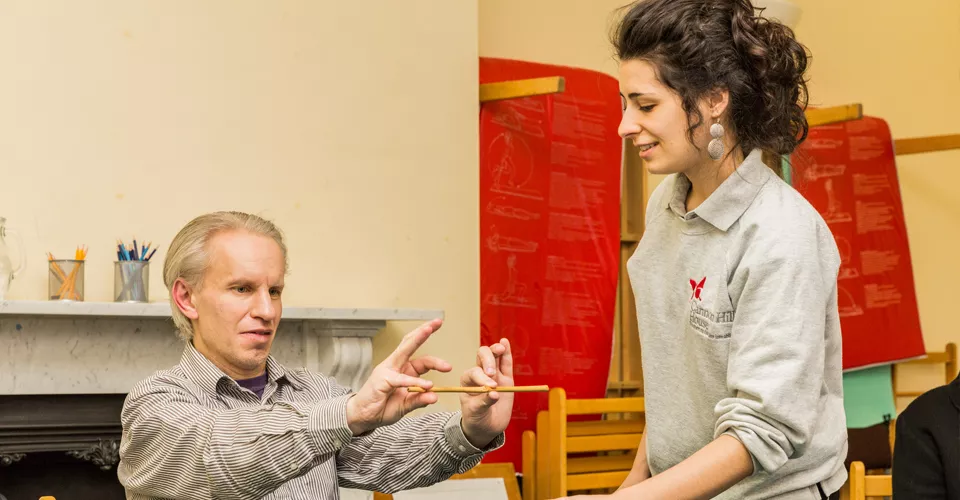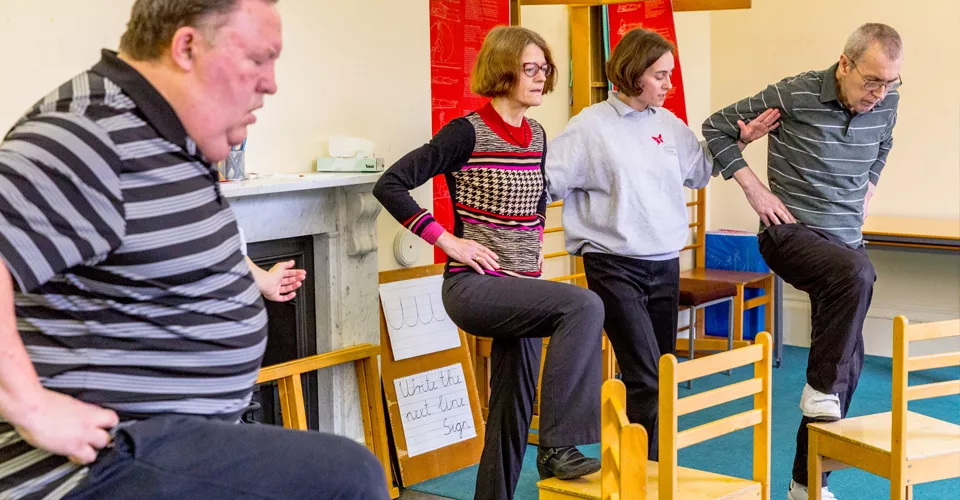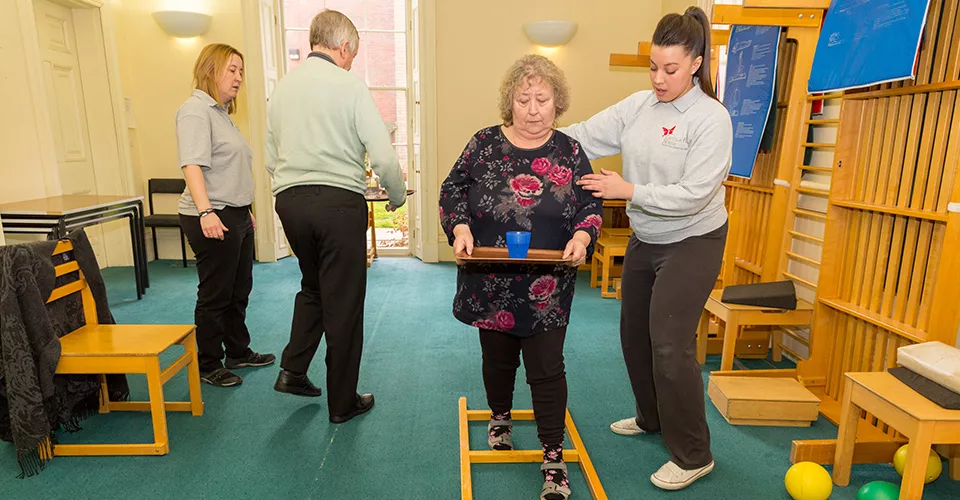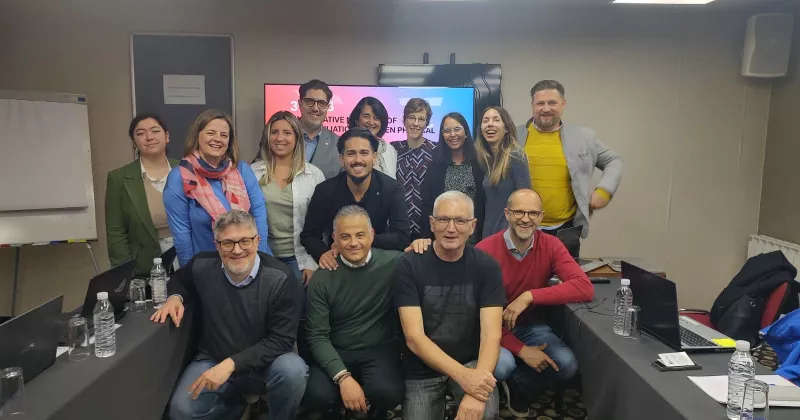Conductive Education: an educational approach to rehabilitation for adults
Dr Melanie R Brown, Director & Senior Conductor of Conductive Rehabilitation Services at the National Institute of Conductive Education in Birmingham, UK, explains what Conductive Education is and how it can benefit adults with neurological motor disorders.
Conductive education
Conductive Education (CE) originates from the work of the Hungarian physician András Pető. Pető developed his ideas while working with children and adults with neurological motor disorders in Budapest, Hungary, after the second world war. Interest in this system, in the UK, began as far back as the 1960s and spread rapidly in the 1980s following a BBC documentary Standing Up for Joe. Whilst this documentary was focussed on CE for children with cerebral palsy, in 1984 the Parkinson’s Disease Society of the UK sent a working party to the Pető Institute to observe the work with adults with Parkinson’s. This led to a proposal for CE to be established in the UK for adults in Birmingham. These services started in 1990.
Who Can Benefit?
CE is an educational approach to habilitation and rehabilitation for adults and children with neurological motor disorders. Motor disorders arise when damage to the central nervous system affects the person’s ability to control movement. Anyone who has suffered a motor disorder can potentially benefit from CE. For example:
- cerebral palsy throughout the life span
- Parkinson’s disease and parkinsonism
- multiple sclerosis and conditions causing demyelination
- stroke
- ataxia.
A medical or educational approach?

Source: conductive-education.org.uk
Pető’s work was revolutionary in that he combined educational methods to complement his medical knowledge. This produced an integrated system of rehabilitation for adults which challenged the solely medical model. A medical model focuses on the course of the condition; considers the extent of the damage to the central nervous system (CNS) and possible effective treatments. Underlying this expertise is frequently an assumption that the actual course of the condition is largely mapped out by the CNS damage. Whilst this is true neurologically, CE believes that the impact and effect of the symptoms can be assisted through learning how to regain control over the body and to perform movements which have been affected by the specific nature of the condition. To achieve this a wide range of principles of teaching and learning are used in order to establish new connections in the brain. The general acceptance of the plasticity of the brain and the link with potential improvement has only occurred within the last decade.
This information alone however is not enough. Within the medical model we refer to people with neurological conditions as ‘patients’. This suggests that they are passive, ill and certainly cannot take control of their future. In CE we see people as ‘learners’, people who have to learn skills and techniques which were previously carried out automatically. This moves the approach to rehabilitation away from the medical model and into an educational model. A model which considers how people learn rather than focussing on what they should learn.

Source: conductive-education.org.uk
A medical model will assume that the patient wants to learn; little consideration will be given to methods of establishing this ‘want’. Equally lack of motivation, depression and loss in confidence and self-esteem are frequent consequences of neurological conditions. If we consider that the overarching aim of all rehabilitation is to improve quality of life then we must take into account the individual as a learner and work in parallel with the psychological and physiological impact on day-to-day life. It is now recognised that quality of life does not only depend on severity of disability but also on psychological well-being.
CE therefore integrates medical knowledge with educational methods, enabling the person with the condition to learn HOW to regain control over their movements. This in turn increases confidence, self esteem and provides problem-solving skills for daily activities.
Format of a CE session
For adults the session usually lasts for 1.5 – 2 hours. During this time the individual will work as a part of a small group of people with the same condition. Group work is seen as an essential part of CE philosophy as it offers an opportunity for individuals to share solutions to problems. It also provides the medium for a positive learning environment. The conductor will work to ensure that all members of the group experience success, face challenges and learn new skills within the comfort of an environment which rewards effort and not just results.
During the session the group will carry out movement-based tasks in a lying, sitting and standing position. The task series are designed to include all movements of the body and include condition specific elements as required e.g. for people with Parkinson’s work on writing and facial expression will be included; for people with multiple sclerosis breathing tasks to help with emptying the bladder and eye tasks may be included.
The tasks

Source: conductive-education.org.uk
Tasks are seen as movements which need to be learnt. The conductor will assist the person in learning how to correct the movement. The conductor’s role is to guide the person towards a solution rather than performing the task for them. This requires very careful use of facilitation as the individual must feel a part of the learning process. CE works along the lines of an apprenticeship between the conductor and the person with the condition. The starting point being what the person and the conductor can achieve together e.g. standing up. Gradually the conductor will then pass over skills to the person, enabling the person to learn how to stand up alone. As with any apprenticeship the conductor must retain the trust and confidence of the person. The transference of skills should be a positive process; not one of failure but one of success. It is however the transference of skills which is the most important. Each person attending must experience success and see development otherwise they will quickly become demotivated and feel that they cannot improve further.
The conductor draws very heavily on teaching methods to achieve success. Tasks may be adapted for an individual; help will be changed as necessary and the skills the person has are promoted rather than focussing on the skills they have lost.
The use of rhythm
CE links speech, thought and movement together. In practice this means that the conductor will say the task which will be performed e.g. I lift my right arm up; the group will then repeat this and then will carry out the movement using a count of one to five. By doing this the conductor is able to help the person focus on the movement they are carrying out and also provide an optimal time scale in which to complete it, thus teaching the person how to overcome the symptoms and carry out the movement more successfully. The use of speech helps the person to internalise the movement and use this outside of the CE session. E.g. when at home the person will frequently say the movement to themselves and carry it out using the count they have learnt. It is very important that carers and family members are also taught how to use these strategies in order to help the application of skills into all aspects of daily life.
Dr Melanie R Brown is CEO & Senior Conductor at the National Institute of Conductive Education, Birmingham, UK.





